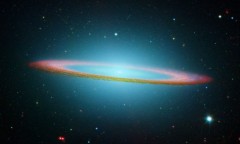By R.See, | February 16, 2017

Astronomers Discover Unconventional Relationship Between Pulsating Star, Exoplanet (NASA/JPL-Caltech/Public Domain)
Astronomers have discovered a pulsating star about 370 lightyears away from Earth. The star system seems to have a distinct relationship with its orbiting exoplanet.
The stellar object seems to be pulsate in sync with its planet's elongated orbit. Astronomers cite that pulsating stars have been found before, but it was between two stars. This would be the first discovery wherein a star would "beat" in relation to its orbiting planet.
Like Us on Facebook
The star, named HAT-P-2, seems to pulse every 87 minutes, which astronomers have calculated that it is consistent with the harmonics of its lone planet's stretched orbit. Scientists have been forward in saying that this type of behavior was the first of its discovery.
The large exoplanet is about the size of Jupiter, albeit heavier - about eight times heavier. The Jupiter-like planet orbits around its host star every 5.8 days, during which time that the star seems to respond to its satellite when it comes close.
The large exoplanet is one of the most colossal planets currently known. HAT-P-2 appears to oscillate about 87 minutes, which directly correlates with the massive exoplanet's elongated orbit.
Pulsating stars are not uncommon in the observable universe, but all pulsating stellar objects known are all star-on-star relationships, which came to be known as "heartbeat" stars. This discovery would mark the first star-planet relationship.
The massive exoplanet's gravitational pull is roughly 24 times greater than that of Earth, which is likely a primary factor of influence on the star. The behavior correlates directly with the multiples of the rate of revolutions the planet makes around the sun.
However, the activity is quite surprising astronomers as this goes against previously calculated theoretical predictions. The large exoplanet is mainly composed of gas - much like Jupiter - but its dense composition means that it has a greater gravitational influence on its star, which causes the surface of the star to flare up.
-
Use of Coronavirus Pandemic Drones Raises Privacy Concerns: Drones Spread Fear, Local Officials Say

-
Coronavirus Hampers The Delivery Of Lockheed Martin F-35 Stealth Fighters For 2020

-
Instagram Speeds Up Plans to Add Account Memorialization Feature Due to COVID-19 Deaths

-
NASA: Perseverance Plans to Bring 'Mars Rock' to Earth in 2031

-
600 Dead And 3,000 In The Hospital as Iranians Believed Drinking High-Concentrations of Alcohol Can Cure The Coronavirus

-
600 Dead And 3,000 In The Hospital as Iranians Believed Drinking High-Concentrations of Alcohol Can Cure The Coronavirus

-
COVID-19: Doctors, Nurses Use Virtual Reality to Learn New Skills in Treating Coronavirus Patients











